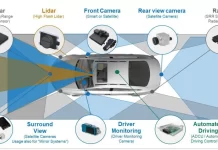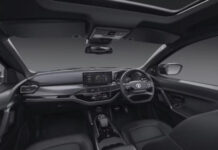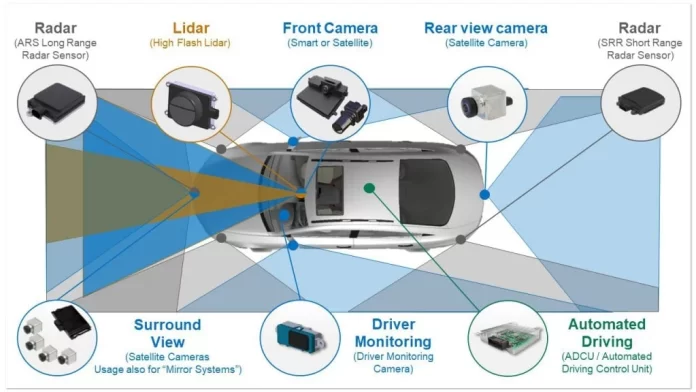Advanced Driver Assistance Systems (ADAS) use sensors, cameras, and detection systems that assist drivers and also enhance vehicle safety. These systems help to reduce human error, with features like collision avoidance, lane departure warnings, and adaptive cruise control, offering alerts and automatic corrective actions to prevent accidents.
With technology bringing positive changes to the automotive industry, our cars are becoming smarter, safer, and more capable. While several technological advancements have truly made vehicles better, ADAS, or the Advance Driver Assistance System, has been one of the key onboard technologies that has revolutionized onboard safety. A suite of electronic functions specifically designed to improve driving comfort and safety, ADAS works primarily to minimise and prevent accidents mainly caused by human error by assisting drivers through active and passive safety systems. From a simple reverse parking sensor to fully automated park assist, all are different levels of ADAS that assist drivers in mitigating the chances of an accident. If you are wondering how ADAS is helping cars become safer, read on to know all about this revolutionary technology.
ADAS Full Form: A Guide to Advanced Driver Assistance Systems

With technology bringing positive changes to the automotive industry, our cars are becoming smarter, safer, and more capable. While several technological advancements have truly made vehicles better, ADAS, or the Advance Driver Assistance System, has been one of the key onboard technologies that has revolutionized onboard safety. A suite of electronic functions specifically designed to improve driving comfort and safety, ADAS works primarily to minimize and prevent accidents mainly caused by human error by assisting drivers through active and passive safety systems. From a simple reverse parking sensor to fully automated park assist, all are different levels of ADAS that assist drivers in mitigating the chances of an accident. If you are wondering how ADAS is helping cars become safer, read on to know all about this revolutionary technology.
How Does ADAS Work?

A comprehensive amalgamation of technology, the Advance Driver Assistance System is an array of several different components such as sensors, controllers, cameras, interfaces and powerful processors that work in synergy to analyze, integrate and interpret real-time driving data in order to make decisions for the driver and reduce the risk of an accident. Some of the most common sensors used in ADAS-equipped cars include long-range RADAR, LiDAR, SONAR etc. that work alongside imaging solutions such as 360-degree cameras that constantly examine the environment around the vehicle, providing this crucial information to an onboard computer that processes the data at a blink of an eye, taking decisions for the driver, much faster than the human reaction time. This helps the car avoid accidents before the driver can react, thereby saving countless lives.
Active and Passive ADAS System
Driving a car on the road is a complex task that involves both attention as well as reflex. Modern-day ADAS suits achieve both of these through both active and passive technologies. Here is what both imply:
Passive ADAS Systems
Aimed at catering to the attention part of driving, passive ADAS systems are designed to inform/alert the driver about an unsafe condition or potential danger. With a passive ADAS onboard, the driver must take action himself to prevent/avoid accidents or mishaps. Common passive ADAS systems include:
- Anti-lock Braking Systems (ABS): Prevents the vehicle from turning and skidding in situations where emergency brakes are applied.
- Electronic Stability Control (ESC): Avoids over-steering and under-steering during unexpected driving scenarios.
- Traction Control System (TCS): Amalgamates the function of both AABS and ESC to help maintain proper traction during curves and turns.
- Rear-Camera: A camera that offers the rear-view of the vehicle for parking and reverse assist
- Lane Departure Warning (LDW): Alerts the driver when the vehicle moves out of its lane.
- Forward Collision Warning (FCW): Warns the driver to apply brakes to prevent forward collision.
- Blind Spot Detection: Alerts the driver if there is a vehicle in the blind spot.
- Parking Assistance: Alerts the drivers when objects approach the front and/or rear bumpers at low speeds for parking.
Active ADAS Systems
Aimed at catering to the reflex part of driving, active ADAS systems are designed to take direct action during an unsafe condition or potential danger. With an active ADAS onboard, the car itself takes action to prevent/avoid accidents or mishaps. Common active systems include:
- Automatic Emergency Braking: Automatically applies the brake to prevent collision with another vehicle/object including pedestrians, animals, hurdles etc. that come in the way of the vehicle’s lane.
- Emergency Steering: Automatically steers the car to prevent collision with anything that comes in the way of the vehicle’s lane
- Adaptive Cruise Control: Automatically adjusts the cruise control speed based on vehicles in front.
- Lane Keeping Assist and Lane Centering: Automatically steers the car to keep it in its late, even during curves.
- Traffic Jam Assist: Blends both adaptive cruise control and Lane Keeping Assist to offer semi-automated driving assistance during bumper-to-bumper traffic events as well as stop-and-go conditions.
- Self Parking: Automated and Self-Manoeuvred parking.
Types of ADAS Technologies
While there are a plethora of constantly developing ADAS technologies that help vehicles achieve safer and more reliable driving, here are a few of the most common ADAS technologies available in modern-day vehicles:
Collision Intervention Systems
Automatic collision avoidance is one of the major benefits of having ADAS equipped in a car. These collision intervention systems constantly detect the road ahead and behind to automatically prevent any oncoming collisions.
Automatic Emergency Braking
Automatic Emergency Braking detects potential collision obstacles, displays collision warning and automatically applies emergency brakes if there is no human intervention to avoid the collision. (Active ADAS)
Automatic Emergency Steering
Automatic Emergency Steering also detects potential collision obstacles and displays a collision warning. The system works in conjunction with AEB to automatically steer away from the obstacle and avoid the collision. (Active ADAS)
Automatic Reverse Braking
Automatic Reverse Braking is active in situations where the car is reversing. The system detects and displays a collision warning for obstacles in the rear of the car. Brakes are automatically applied if there is no intervention from the driver. (Active ADAS)
Collision Warning System
Collision Warning Systems alert the driver for any potential obstacles. These systems act as a first level of assistance for the driver to stay alert on the road.
Blindspot Alert
Driver warning to alert about a vehicle in the blind spot. (Passive ADAS)
Forward Collision Alert
Driver warning to alert about the detection of a potential collision with a vehicle ahead. (Passive ADAS)
Lane Departure Alert
Driver warning to alert about the vehicle departing from its lane and drifting over lane markings. (Passive ADAS)
Parking Collision Alert
Detection of potential collision obstacles during parking manoeuvres followed by a warning to avoid collision. (Passive ADAS)
Rear Cross-Traffic Alert
Detection and warning for side and rear-approaching vehicles during reverse manoeuvres. (Passive ADAS)
Driving Control Assist
Driving Control Assist actively help the driver while driving on city and highway roads.
Adaptive Cruise Control
Automatically adjusts braking and/or acceleration to maintain a uniform speed based on distance from the vehicle ahead. (Active ADAS)
Active Drive Assist
Automatic assistance of steering, braking and acceleration based on surrounding conditions and alerts. (Active ADAS)
Active Lane Assist
Automatic steering assist to keep the vehicle in its lane and prevent lane marking deviations. (Active ADAS)
Parking Assist
Parking assist systems are a relatively new development as part of the ADAS suite on car. These systems have so far only appeared on flagship luxury cars.
Active Parking Assistance
Automated control of steering, braking and accelerating during parking manoeuvres; Some systems might need the driver to be in charge of shifting, braking and steering; Some systems can also be fully capable of parallel parking and/or perpendicular parking. (Active ADAS)
Remote Park Assist
Fully automatic parking without the need for the driver to be present inside the vehicle with automated control over brake, steering, shifting, and acceleration. (Active ADAS)
Other Driving Assistance Systems
While not advertised as part of any ADAS suites, these driving assistance systems are still helpful for drivers.
Automatic Headlamp
Automatically turns on the headlamps during darker environments, automatic high and low beam switching as well as automatic light direction determination as per driving condition. (Active ADAS)
Reverse Camera
Provides the rear-end view of the vehicle’s surroundings to assist reversing manoeuvres. (Passive ADAS)
Brake Assistance
Automatic application of brakes, emergency brakes with automatic brake pressure determination based on vehicle surroundings. (Active ADAS)
Driver Monitoring System
Monitors driver and driving behaviour to alert when the driver is not fully engaged in driving through eye movement and head tracking. (Passive ADAS)
Heads Up Display
Image projection of vehicle data and/or navigation cues in front of the driver’s line of sight. (Passive ADAS)
Night Vision
Improves vision at night by projection of high resolution and/or enhanced frontal view on the instrument cluster. (Passive ADAS)
Roll Over Mitigation
Mitigates vehicle rollover by braking one or more wheels and reducing the power of the engine in sudden and/or evasive turning manoeuvres.
Tyre Pressure Monitoring
Monitors tyre pressure in all four wheels and alerts the driver when the pressure is low.
Speed Alerts
Alerts the driver when the vehicle overspeeds.














































